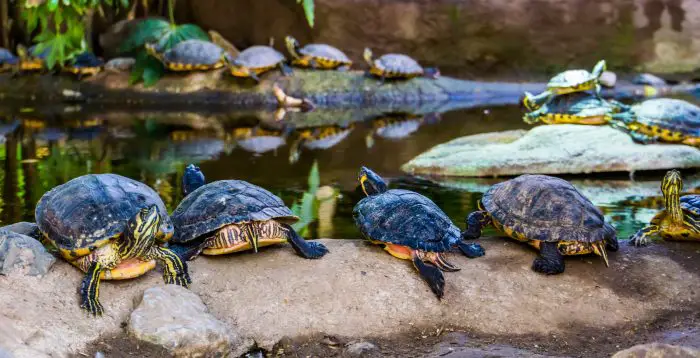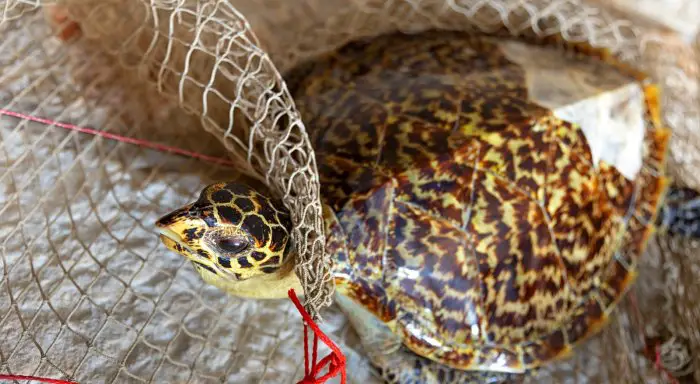Terrapins are remarkable creatures that inhabit a variety of ecosystems, from salt marshes to freshwater ponds.
However, behind the beauty and mystique of these remarkable reptiles lies a more somber reality: some terrapin species and subspecies face an uncertain future due to a multitude of threats, ranging from habitat loss and pollution to the pet trade.
So, are terrapins endangered?
The answer is more nuanced than a simple yes or no. While it’s easy to classify terrapins under a single umbrella, the term actually represents a number of species and subspecies, each with its own distinct habits, habitats, and risks. Some may be thriving in the wild, but others are teetering on the brink of endangerment—or are already there.
Adding to the complexity of the issue is the fact that terrapins have been classified as an invasive species in the United Kingdom since 2016. The ensuing ban makes it illegal to buy and breed them.
The goal was to avoid the risk of terrapins in the wild destroying the country’s native ecosystems. Given the precarious nature of some terrapin subspecies, though, should this ban be lifted? How much of a risk do terrapins actually pose?
Terrapins in the wild
It is believed that there are currently around 4,000 terrapins released across the United Kingdom. While that doesn’t sound like much, some experts worry that they can easily unbalance fragile ecological environments and become an invasive species in ponds across the country.
Thankfully, while terrapins seem to have adapted to the UK’s environment, the terrapins that wildlife specialists are finding in the wild are adults rather than young ones.
This suggests that terrapins haven’t been able to successfully reproduce.
Even so, the government has categorised terrapins as invasive in order to protect the original ecosystems. Only terrapin owners that have had their terrapin before 2016 are allowed to keep them in an enclosed environment, as long as they don’t reproduce.
A precarious present—and future
Life in the wild is dangerous for terrapins. Even in their original habitat, on the east coast of the United States and across the Gulf of Mexico, terrapin populations have been under threat. As marshes and estuaries are exposed, terrapins are susceptible to expanding cities, overfishing, and pollution.
As a result, diamondback terrapins have been listed on the IUCN Red List as Vulnerable since 2018. Although not immediately endangered, there is increasing concern that populations are not growing fast enough—or even remaining stable—in their natural habitats. This has raised the alarm about the survival of certain terrapin subspecies.
What is threatening terrapins in their natural habitats?
There are four major factors that threaten terrapins in their natural habitats.
Habitat destruction
Terrapins live in brackish waters, where rivers meet oceans. They need water and land to survive which is why they thrive in estuaries, marshes, and ponds to thrive.
Unfortunately, such environments are endangered: marshes and wetlands are disappearing three times faster than forests.
From climate change to soil erosion, there are many reasons why such delicate environments are declining:
- Climate change has made hurricanes stronger and more catastrophic when they land on marshes and on land, generally. Marshes and wetlands are frail ecosystems and high winds and rainstorms beyond the normal average can uproot them.
- Cities and towns have expanded and are slowly encroaching on such environments. New Orleans, for example, is built of wetland. As the city spreads, it inevitably captures land that was terrapin territory.
- Pollution is challenging the survival of animals and plants in these areas. Floating plastics, rubbish, and pollutants are degrading the quality of terrapin habitats.
- Soil erosion and deforestation farther up from marshes and wetlands are unbalancing the fragile ecosystems that supply food and provide shelter to terrapins.
As their natural environment becomes less safe and nutritious, terrapins find it hard to reproduce—or, indeed, survive.
Fishing gear and nets
Terrapin territory often overlaps with crab fishing areas. Many terrapins get trapped in crab traps that have been forgotten or lost by their owners. These traps linger in the sea and terrapins often find their way into them. Crab-fishing nets can thus become death traps for any terrapin that gets entangled and can’t escape.
Run over by vehicles
Terrapins live on land and sea, which means they are threatened by both maritime and terrestrial dangers.
There are increasing reports of terrapins being run over by cars. Terrapins have no knowledge of how to avoid cars and motor vehicles because they are wild animals that are not supposed to live close to urban areas. Sadly, they often fall prey to cars as they look for nesting grounds. Terrapin babies are particularly vulnerable to road accidents due to their smaller size.
Terrapin trafficking
Sometimes, terrapins are being trafficked and removed from their wild habitats by poachers. People across the world are fascinated by these animals and there is increasing demand for terrapins as pets. The ban on their import and breeding has only served to push trafficking underground.
Terrapins as a delicacy
Some terrapins are trafficked as food. Terrapins are still perceived as gourmet food in many cultures, particularly in East Asia, while Native Americans used to eat them as well. Also, terrapins were considered a delicacy in the United States and were served in the poshest restaurants until the beginning of the 20th century.
Of course, the number of terrapins consumed in the past was nowhere near the current demand for terrapins as a delicacy. Such demand is another cause for terrapin trafficking across the world.
Terrapins are under threat worldwide
Terrapins have grown and bred in brackish waters, where rivers meet the sea. They are part of the local wildlife and should be protected.
Climate change, pollution, and human intervention have caused a decline in terrapin populations to the point that some subspecies are now considered vulnerable. As urban spaces intrude into terrapin territory, these animals experience loss of habitat and food sources.
A hopeful future?
Thankfully, there is increasing attention paid to the preservation of terrapin habitats internationally. In addition, terrapin trafficking is closely monitored by many wildlife organisations that aim at ending it.
At the same time, terrapins have been labelled as an invasive species in the United Kingdom to preserve the fragile ecosystems around ponds and estuaries.
It is currently estimated that there are 900,000 turtles, tortoises, and terrapins held as pets across British households compared to the estimated 4,000 living in the wild that caused the 2016 ban.
This, along with the apparent failure of terrapins to reproduce in the wild, suggests that the problem is not as acute as some studies suggested. Given the pressure placed on terrapin populations by humans worldwide, perhaps the ban will be lifted in the future and people who love terrapins will find it easier to enjoy the company of their favourite animals.


